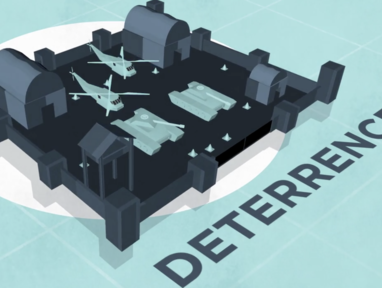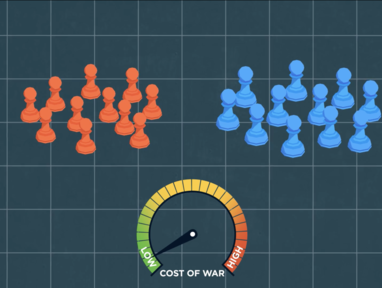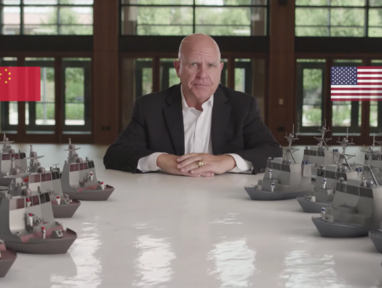Deterrence

As we are seeing in Ukraine today, the world remains a dangerous place. Aggressive actors, from Russia to North Korea, are eager to use their military might to enhance their power. Stopping these aggressors before they lash out is key to preserving human life and avoiding costly wars, but the question is how?
In this month’s Policy Insights, we consider the role deterrence plays in preserving and restoring peace.
What is deterrence?
Deterrence is the capability to prevent other actors from pursuing military action to achieve their political goals. As the video below explains, successful deterrence requires three ingredients: “the capability to act, the credibility that we’ll follow through on threats, and clear communication about what we’ll accept and how violators will be punished.”
Political leaders opt for war when they believe military action will help them achieve their political aims at sufficiently low costs. In a 2017 Uncommon Knowledge interview, historian Victor Davis Hanson points to the Second World War as an example where both sides miscalculated their relative capabilities and potentials:
They didn’t understand fully their capability and their potential. [The Allies] underestimated their power, and the Axis always overestimated their capability. War is a laboratory. What it does is it says these are realities. You have impressions about realities that are often false. War is unnecessary, because if everybody just had to turn and they knew exactly what everybody in this room, their relative capability is, you wouldn't fight.
Deterring armed conflict thus requires the perceived costs to be high enough to discourage bad actors. The video below explains this calculus in detail:
As the video explains, “Preventing wars isn’t possible without a strong commitment to establishing deterrence and the willingness to use force to stop aggressors.” By raising the perceived costs of military action, we encourage would-be aggressors to pursue peace rather than war. General H. R. McMaster refers to this as “deterrence by denial.” He points to the importance of deterrence by denial in preventing the People’s Republic of China (PRC) from trying to subjugate Taiwan:
As McMaster explains, the Taiwanese government has invested heavily in air defenses and shore-to-ship missiles, among other defenses, to “to convince the PRC it cannot succeed” in any invasion of Taiwan.
What is the importance of credibility?
Deterrence is only effective if a foreign adversary takes us seriously. Credibility matters. That means being willing to respond with force if necessary. When belligerent nations no longer believe the United States will deliver on its threats of force, they behave more aggressively. History is replete with examples of empty threats producing horrific outcomes. Unenforced threats of punishment emboldened Adolf Hitler, Saddam Hussein, and, more recently, Bashar al-Assad. As the video below explains: “The consequences of making empty threats are very real. They teach our enemies that they can get away with violence and aggression against us or others whom we wish to protect.”
Making empty threats also reduces trust among a nation’s allies. As the video explains, they “cause our allies to turn elsewhere for leadership, destroying the trust that takes years to develop.” In short, as the late George Shultz explained in the video below: “If you’re a person who does what you promise to do, then people can trust you and they can deal with you.”
The example of World War II looms large. The Allied powers—the US, Great Britain, and the USSR—were far stronger than the Axis powers, but they didn’t act like it. The video below explains the consequences of the Allies’ failure to display strength:
As the video argues, “the Allies projected weakness and timidity from the outset.” The result was a costly war that would finally make it clear to all that the Allies were indeed stronger. That did not have to be the case: “The devastating reality is that if the Allies would have demonstrated their power from the beginning—and their willingness to use it—it might have averted World War II and saved millions of lives.”
What happens when deterrence fails?
While a successful and credible foreign policy strategy will deter many would-be aggressors, a perfect, lasting peace is unlikely. When deterrence fails and military force is required, it is incumbent on civilian and military leaders to identify a “clear political end state,” or, in short, what success looks like. This video explains why clearly defined end states are so important to successful military engagements:
Failing to develop and articulate realistic end states can lead to tragedy. Kori Schake highlights two recent failures:
President Bush defined political end states for Afghanistan and Iraq that were not achievable by the means he was willing to invest. President Obama gave primacy to ending American involvement in the wars irrespective of the political end states. What both failures have in common is an inability to marry ends and means. Since strategy consists of matching those two things, it is axiomatic that neither president acted strategically.
Schake answers related questions on the importance of political end states in this video:
Conclusion
The painful lessons we are learning in Ukraine aren’t novel. Throughout history, nations have attacked other nations when they think the benefits will outweigh the costs. Overcoming this historical pattern demands effective deterrence by the United States and its allies.
Additional Reading:
We unpacked Putin’s war in Ukraine in an earlier Policy Insights.
General H. R. McMaster explores the many geopolitical issues facing the United States in the video series Battlegrounds. Among other chapters in the series, McMaster considers how the US should deal with a belligerent Russia under Vladimir Putin.









